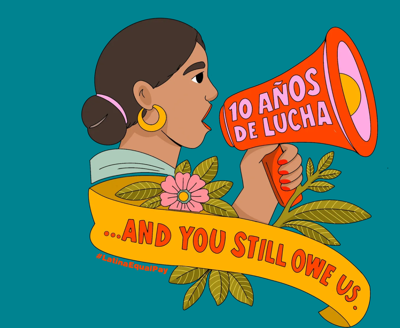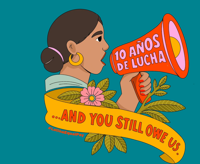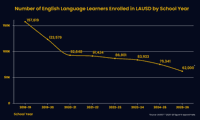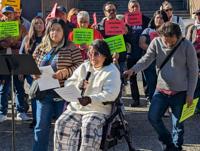
(Art courtesy of Justice for Migrant Women.)
Last week, Justice for Migrant Women, a national non-profit organization, published a new report marking the tenth anniversary of Latina Equal Pay Day, observed on October 8. The report sheds light on the persistent wage gap Latinas face, revealing they earn only 54 cents for every dollar paid to white, non-Hispanic men. This figure includes Latinas working part-time, seasonally, part-year and in the gig economy.
Justice for Migrant Women was founded by Mónica Ramírez, with a mission to amplify and empower migrant women through education, advocacy and public awareness.
“Over the past decade, we’ve helped achieve stronger laws and greater inclusion of individuals too often left out of the conversation,” said Ramirez. “Yet Latinas, especially immigrant women and those in rural communities, still make barely half of what white, non-Hispanic men make, highlighting the persistent pay gap across education levels nationwide and the urgent need for policy solutions that address the unique circumstances of Latinas from different backgrounds. This anniversary is not only a moment to reflect on progress, but also a call to collective action to achieve true economic justice for all women and for the future of our country.”
According to the Institute for Women’s Policy Research, Latinas faced the worst wage gap in California. Based on trends from 2002 to 2022, it will take until 2207 for all Latinas with earnings to reach pay equity with white, non-Hispanic men, and until 2171 for full-time year-round working Latinas.
The data by Justice for Migrant Women also highlights that more than 19 million women in rural communities make just 43 cents for every dollar paid to white, non-Hispanic men. Women living in rural parts of the United States include individuals of many diverse backgrounds, including Latina, Indigenous and Native, Black, and Asian women, as well as women of other races and ethnicities. Latinas living in rural communities face greater challenges when it comes to economic security.
When examining Latinas from various backgrounds, the wage gap becomes even more severe, Guatemalan and Honduran Latinas in the U.S. earn just 29 cents for every dollar earned by white, non-Hispanic men. For immigrant Latinas, many of whom have escaped violence and now face unstable living conditions, these low wages not only deepen existing vulnerabilities but also increase their exposure to physical and mental health risks.
Latinas in the U.S. face a range of barriers to accessing mental health care, many of which are rooted in systemic inequality, cultural stigma and socioeconomic challenges. Barriers to mental health care within Latino communities cause individuals to suffer in silence. Only 47.4 percent of Hispanic adults ages 18 or older with any mental illness received services in 2023.
Additionally, the data confirms that the pay gap cannot be attributed to lack of qualifications, as it persists across education levels: on average, Latinas with a professional degree make just 38.9 cents for every dollar made by white males, with reported earnings of $48,020 and $123,300, respectively. The disparities extend across industries and sectors as well:
● Latinas who are employed as actors, producers, and directors make, on average, 70
cents for every dollar made by white, non-Hispanic men.
● Latinas employed as waitresses make, on average, 87 cents for every dollar made by
white, non-Hispanic men.
● Latinas employed as bartenders make, on average, 76 cents for every dollar made by
white, non-Hispanic men.
● Latinas employed as chief executive officers, legislators, or public officials make, on
average, 59 cents for every dollar made by white, non-Hispanic men.
● Latinas who are lawyers, judges, magistrates, or another type of judicial worker make, on average, 67 cents for every dollar made by white, non-Hispanic men.
“We are now more aware of how we are being treated, how we’re being paid, where the disparities are, and where the issues lie. And, we’re fighting back,” said Lisa Vidal co-founder, Latinas Acting-Up.
What began ten years ago as a coordinated day of action among Latina women and worker movements has evolved into a global movement. Today, Latina Equal Pay Day unites hundreds of organizations, advocates and millions of people, becoming a powerful symbol in the fight for economic justice across the U.S., Mexico and Latin America.
“National Latina Equal Pay Day is not just a date on the calendar, it’s a reminder that more than 22 million Latinas power America’s workforce, families, and communities every single day,” Ramírez said. “When Latinas are underpaid, the entire U.S. economy feels it. Our advocacy doesn’t stop when this day ends; it is year-round work. We are proud to stand with partners and allies who know that closing the wage gap for Latinas is not just about fairness, it’s about unlocking prosperity for the whole country.”
According to the organization and the data presented, closing the wage gap for Latinas will require collective action and bold policy changes. This includes collaboration among communities, business leaders and lawmakers to protect and expand access to pay gap data, strengthen enforcement of labor and civil rights laws, pass the Paycheck Fairness Act and implement equitable pay practices across all sectors.











(0) comments
Welcome to the discussion.
Log In
Keep it Clean. Please avoid obscene, vulgar, lewd, racist or sexually-oriented language.
PLEASE TURN OFF YOUR CAPS LOCK.
Don't Threaten. Threats of harming another person will not be tolerated.
Be Truthful. Don't knowingly lie about anyone or anything.
Be Nice. No racism, sexism or any sort of -ism that is degrading to another person.
Be Proactive. Use the 'Report' link on each comment to let us know of abusive posts.
Share with Us. We'd love to hear eyewitness accounts, the history behind an article.